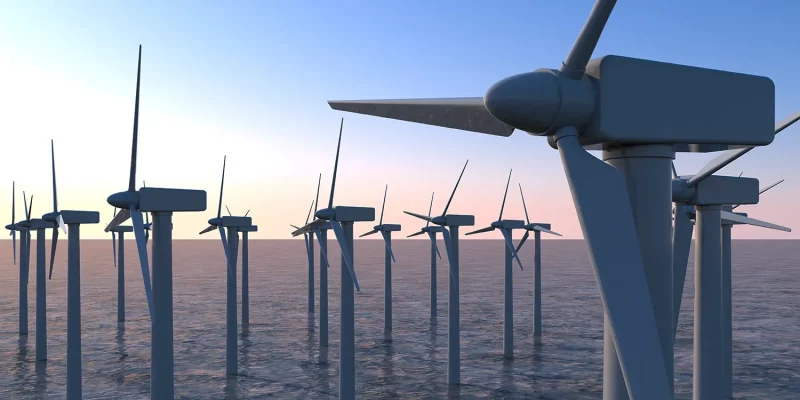Wind Energy
For our wind energy farms, we hire reputable power suppliers; in a market where prices are constantly rising, we offer long-term, fixed pricing; and we also reduce CO2 emissions, the main greenhouse gas.
Through payments to landowners and tax revenues, our wind energy projects help the communities where we operate while also generating jobs in construction, manufacturing, and wind project management. The operating wind farms of INTIO Energy Services are some of the best in the sector, working toward building a clean energy future for communities across Africa and LATAM.
How does wind power work?
The ability of a group of wind turbines to generate electricity for the utility grid is demonstrated in this aerial view of a wind turbine plant. Transmission and distribution lines transport the electricity to buildings such as residences, workplaces, schools, and so forth.
The process of using the wind to produce mechanical or electrical energy is known as “wind power” or “wind energy. The kinetic energy of the wind is transformed into mechanical power by wind turbines. This mechanical energy can be applied to particular tasks (like pumping water or grinding grain) or can be transformed into electricity by a generator.
The process of using the wind to produce mechanical or electrical energy is known as “wind power” or “wind energy. The kinetic energy of the wind is transformed into mechanical power by wind turbines. This mechanical energy can be applied to particular tasks (like pumping water or grinding grain) or can be transformed into electricity by a generator.
Wind Turbine Sizes and Applications
The energy produced by wind turbines can be used locally or exported and sold. The size of the turbine will depend on the amount of energy required. When the project size is created to match the energy requirements of the load while also monetizing economies of scale and the track record of the equipment, wind turbine economics are maximized. A small turbine (typically less than 10 kW) that can produce the amount of power needed by a home for daily operation is needed for residential onsite energy use. The energy output of midsize machines can support heavier commercial onsite loads. The best machines for utility-scale projects are those that maximize generation while minimizing cost and site infrastructure footprint. No matter the size of the project, electrical grid connections need utility approvals and may need grid impact studies before construction can start.
Residential-Scale Onsite Energy Use (10 kW)
Small residential turbines can generate about as much energy as a house needs. You need a site evaluation to decide where to site the project in order to ensure that it will perform as intended because these turbines are typically installed on shorter towers. The return on investment should be taken into account, but since these wind turbines were paid for in full, it is not always the determining factor in whether a project will proceed. For this type of machine, numerous states offer incentives. A thorough onsite resource assessment is typically not necessary for small-scale residential wind farms.
Small commercial-scale onsite energy use (10–50 kW)
This type of wind turbine can be used for public loads like hospitals as well as small businesses, farms, ranches, office buildings, schools, and other facilities. It also produces more energy than the typical home uses. This turbine class typically uses more sophisticated machinery, which increases efficiency and power output but also necessitates more frequent maintenance. However, compared to larger machines, these turbines typically require less maintenance. The smallest project size that might be financed and necessitate a lender review is this class of machine, which can cost as much as a house. This size of project may also necessitate onsite resource assessment, but frequently, projects can proceed using nearby measurements.
Commercial Onsite Energy Use (50–250 kW)
This category of wind turbines generates power in commercial quantities and is a good fit for campuses, larger buildings, communities, and public loads for municipalities. This class of wind turbines is frequently installed on towers that call for special permits and coordination with other regulatory organizations or agencies. This class of wind turbines shares many technical and operational characteristics with utility-scale machines. These turbines frequently require a sizable capital investment, so corporate or institutional approvals are necessary. Facility managers frequently collaborate with financial actors when creating projects of this scale. These projects call for skilled project modeling that uses local or nearby wind resource data.
Large Commercial or Industrial Energy Use (500 kW–1.5 MW)
This wind turbine class, which is at the top of the midsize machine spectrum, is well suited for communities and very large onsite industrial loads. In some circumstances, it can even serve as the foundation for small wind farms. On a technological level, this machine class is typically identical to utility-scale turbines. Obstruction lighting must be installed on the towers, which frequently reach heights of more than 200 feet. Projects of this size demand support from the community and approval at all levels. Except in extremely rare circumstances, this class is typically funded by commercial lenders, each of whom has their own due diligence standards. As a result, feasibility studies and on-site resource assessment campaigns are necessary.
Utility-scale energy use (1.5–7.5 MW)
Utility-scale wind turbines are typically installed in large groups and produce energy for sale, though they are also occasionally installed at the point of use. These are cutting-edge, highly efficient wind turbines that operate with incredibly high availability rates and produce electricity at power plant scales that are competitively priced. These massive turbines, whose tower-mounted installation necessitates the notification of aviation obstructions and lighting, have rotors that are more than 250 feet in diameter. Large-scale wind turbines require the highest levels of coordination between the environmental, utility, and public sectors due to their size and the scale of the installations. Exacting resource assessments, legal and financial due diligence, utility integration, and financing typical of very large capital investment installations, like airports, are needed for utility-scale wind farms.

How we help
INTIO Renewable Energy focuses on financing and investing following the triple bottom line principle of social, economic, and environmental accountability and sustainable investment, while meeting Sustainable Development Goals (SDG). We work with venture capital, private equity funds, family offices, and investment banks dedicated to green investment vehicles that do not invest in carbon based energy technology. Our private equity division is focused on renewable energy, with the specific aim of increasing technology innovation through exposure to projects across Eurasia, Sub-Saharan Africa, and Latin America.
Need more information?
Tell us about the challenges your business faces and find out how partnering with INTIO could make the difference.
We partner with large wind energy project suppliers to work toward building a clean energy future for communities across Africa and LATAM. Our operations and expertise range from origination, development, transaction, and construction (EPC) to optimization of assets.

